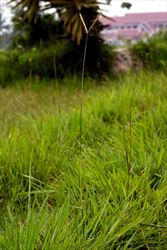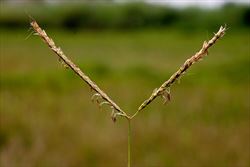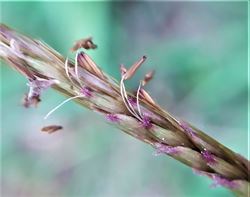- Widespread. In Australia, Fiji, FSM, French Polynesia, Niue, PNG, Samoa, Solomon Islands, Wallis and Futuna.
- Perennial, invasive grass of disturbed areas, forming dense, fast-growing mats in pastures, crops, forest openings, ditches, and on hillsides and roadsides. Adapted to many soil types, high rainfall, waterlogging, moderate shade, but not drought. Indirect impact as host of rice sheath blight.
- Spread: vegetatively on creeping stems that root; seed; intentional spread as a tropical pasture grass.
- Biosecurity: risk is seed as a contaminant of other pasture grasses and legumes. Check imported machinery/vehicles.
- Biocontrol: none.
- Cultural control: hand-weed; slashing (but stem pieces regrow and may be spread in cloven hoofs of livestock). Clean soil, seed and cuttings from machinery/vehicles.
- Chemical control: IRRI lists thiobencarb, pendimethalin, and mixtures of thiobencarb and propanil, among others for control of related Ischaemum rugosum in rice. In Fiji, glyphosate.
Pacific Pests, Pathogens and Weeds - Online edition
Pacific Pests, Pathogens, Weeds & Pesticides
Batiki blue grass (511)
Batiki blue grass; it is also known as Indian murainagrass, or smut grass. The last name is presumably because of susceptibility to the smut, Sphacelotheca ischaemicola, in Asia and Papua New Guinea, which attacks the inflorescence.
Polytrias indica. Previously, it was known as Ischaemum indicum, among many other synonyms. It is a member of the Poaceae. Note, Flora of China states: "This grass has been widely known as Ischaemum indicum (Houttuyn) Merrill (Phleum indicum Houttuyn), but that name in fact refers to a species of Polytrias". Kew (Plants of the World Online) accepts Polytrias indica as the correct name with Ischaemum indicum as a synonym. However, the identity of the plants in Pacific island countries is not clear. Australia is a likely source of the grass for those countries where Ischaemum indicum is presumed to be present but, in Australia, collections have been identified as Ischaemum indicum and also Ischaemum tropicum. Under the circumstances, it is best if specimens are collected from Pacific island countries and re-dentified by a grass taxonomist.
The images are all from WIKTROP as Ischaemum ciliare Retz.The website lists several Ischaemum indicum varieties as synonyms. The Royal Botanic Gardens Kew, Plants of the World Online also list Ischeamum indicum as a synonym of Polytrias indica (Houtt.) Veldkamp.(https://powo.science.kew.org/taxon/urn:lsid:ipni.org:names:963150-1). POWO (2022). Plants of the World Online. Facilitated by the Royal Botanic Gardens, Kew. (http://www.plantsoftheworldonline.org/).
AUTHORS Grahame Jackson & Makereta Ranadi
Information from Ischaemum ciliare. Tropical forages. (https://www.tropicalforages.info/text/entities/ischaemum_ciliare.htm); and Giruja T, MV Menon (2019) Diversity of weed flora in pineapple plantations of Kerala Journal of Crop and Weed 15(1): 218-221. (https://www.cropandweed.com/archives/2019/vol15issue1/15-1-37.pdf); and Juraimi AS et al. (2008) Floristic Composition of Weed Community in Turf Grass Area of West Peninsular Malaysia. International Journal of Agriculture and Biology 11(1). (https://www.researchgate.net/publication/242083402_Floristic_Composition_of_Weed_Community_in_Turf_Grass_Area_of_West_Peninsular_Malaysia); and Flora of China (2006). Volume 22: 609-619. (http://flora.huh.harvard.edu/china/PDF/PDF22/Ischaemum.pdf); and Khan MA, et al. (1991) Rice hosts of rice tungro-associated viruses and leafhopper vectors. Plant Disease 75(9): 926-930. (https://www.apsnet.org/publications/PlantDisease/BackIssues/Documents/1991Articles/PlantDisease75n09_926.PDF); and Ischaemum ciliare (PROSEA). Pl@ntUse. Plant Resources of South-East Asia. (https://uses.plantnet-project.org/en/Ischaemum_ciliare_(PROSEA); and Ischaemum rugosum Salib. Rice Knowledge Bank. IRRI. (http://www.knowledgebank.irri.org/training/fact-sheets/item/ischaemum-rugosum-salisb); and from Ischaemum ciliare Retz., Poaceae. Pacific island ecosystems at risk (PIER). (http://www.hear.org/pier/species/ischaemum_ciliare.htm). Photo 1-4 Ischaemum ciliare Retz. WIKTROP - Weed identification and knowledge in the tropical and Mediterranean areas. (https://portal.wiktrop.org/species/show/801). Photo 5 POWO (2022). Plants of the World Online. Facilitated by the Royal Botanic Gardens, Kew. (https://powo.science.kew.org/taxon/urn:lsid:ipni.org:names:963150-1).
Produced with support from the Australian Centre for International Agricultural Research under project HORT/2016/185: Responding to emerging pest and disease threats to horticulture in the Pacific islands, implemented by the University of Queensland, in association with the Pacific Community and Koronivia Research Station, Ministry of Agriculture, Fiji.








